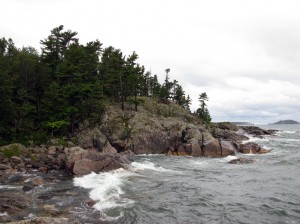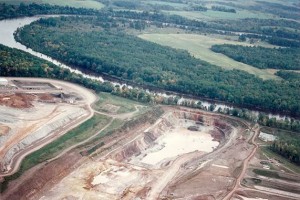Via Telefax delivery:
March 20, 2013
The Honorable Richard “Doc” Hastings
Chairman, Natural Resources Committee
1203 Longworth House Office Building
Washington, DC 20515
Fax: (202) 225-5929

Waves crashing on the rocky shoreline by Jacob Emerick
The Honorable Edward J. Markey
Ranking Member, Natural Resources Committee
2108 Rayburn House Office Building
Washington, DC 20515
Fax: (202) 225-4273
Dear Chairman Hastings and Ranking Member Markey:
We write regarding the upcoming testimony of Mr. James Iwanicki, Engineering Manager of the Marquette County Road Commission. Mr. Iwanicki is scheduled to provide testimony at a hearing on “America’s Mineral Resources: Creating Mining and Manufacturing Jobs and Securing America.” His testimony is slated to take place this Thursday, March 21, 2013, before the Subcommittee on Energy and Mineral Resources (Committee). We also ask that you allow the voices of those whose homelands are being sacrificed in the name of foreign mining companies currently operating in an irresponsible and unsustainable manner in the Upper Peninsula of Michigan to be heard.
Collectively, we are members of a federally recognized Indian tribe, former resource extraction industry regulators, and environmental advocacy groups made up of many of the more than 200 practicing physicians, clergy, property owners, workers, residents, and frequent visitors of the Upper Peninsula who oppose irresponsible mining activities currently underway. Many of us provided testimony and written comments describing our concerns and made recommendations for the proposed mine haul road that Mr. Iwanicki is slated to testify about before the Committee. Unlike Mr. Iwanicki, whose responsibilities are limited to road maintenance and construction in Marquette County, Michigan, we are prepared to provide the House Natural Resources Committee or any of its subcommittees, with a concise description of the unsustainable practices that threaten our resources, including treaty protected tribal trust resources, our environment and our way of life.
We expect that the testimony provided Mr. Iwanicki will downplay the relationship of the road to Rio Tinto’s operations and that the Committee will be told that the road would enhance safety, recreation and “economic benefits for county residents.” Because Mr. Iwanicki’s responsibilities are limited to roads there are many aspects of this debacle of which the Committee will not be apprised. Many are directly related to the primary purpose of the hearing. Mr. Iwanicki is likely unprepared to talk about the impacts this proposed road would have had to National Wild and Scenic Rivers, the McCormick Wilderness, and the health and way of life of the people who work, live and recreate in this area. This is the case because there was no environmental impact statement prepared for the road project. This was possible only because Rio Tinto, which claimed that it would fund the road entirely but only if the project could be permitted within a truncated timeframe that did not allow for the analyses required by federal law.
We believe that Mr. Iwanicki will inform the Committee that he was operating under a budget set by Rio Tinto and under a timeline set by Rio Tinto. We urge the Committee to question Mr. Iwanicki accordingly and specifically ask for an explanation that reconciles the obvious elimination of any use of federal transportation funds to avoid National Environmental Policy Act (NEPA) requirements with the exclusive use of Rio Tinto funding. It’s only reasonable to conclude that if the project has all of the benefits that Mr. Iwanicki will tell the Committee it has, using some federal transportation funds would be acceptable. This however was impossible for Mr. Iwanicki as a result of Rio Tinto’s arbitrary time limit. By setting the timeline and funding limitations Rio Tinto simply made it impossible to incorporate mitigation requirements to fulfill the Clean Water Act’s wetlands protection mandates. Rio Tinto maintained control over the project Mr. Iwanicki was charged with managing. It’s important to note that Mr. Iwanicki only became the manager of this proposed project when Rio Tinto’s own road proposal failed to meet these same federal requirements. The failure here is not EPA’s, but Rio Tinto’s failure to recognize and comply with federal environmental protection laws.
Because the proposed road was primarily for the purpose of avoiding traffic problems associated with Rio Tinto’s mining activities, there are literally dozens of substantive natural resource related issues and legal concerns that Mr. Iwanicki will not relate to the Committee. For example, Mr. Iwanicki is not likely to tell the Committee that while Rio Tinto touts the use of health impact assessments through its role as a member of the International Council of Mining and Metals, none has been prepared for any of the activities Rio Tinto has conducted in the Upper Peninsula of Michigan. The Natural Resources Committee also will not learn how Rio Tinto obtained permits from the State of Michigan to construct and operate a hard rock mine with insufficient financial responsibility assurances in place as EPA fails to complete its rulemaking to address the inability of our government to continue to clean-up the millions of pounds of toxic chemical releases to our environment from these mines each year. Mr. Iwanicki will surely not explain the regulatory fiasco at Rio Tinto’s Eagle mine where a State of Michigan ground water permit is the only thing in place to regulate up to 504,000 gallons of industrial mine water discharges that Rio Tinto itself told the EPA were “not discharged below the surface of the ground.” Additionally, we are very certain that Mr. Iwanicki will not tell anyone at the hearing that State of Michigan water program technical staff who worked on Rio Tinto’s Eagle mine permits and the Governor of Michigan’s Upper Peninsula District Manager who had a very significant role during the permitting process are now on Rio Tinto’s payroll and working at the Eagle mine.
Through his testimony, we expect that Mr. Iwanicki will explain how the U.S. Environmental Protection Agency (EPA), through what has been described by our Congressional representative as “regulatory overreach,” eliminated employment opportunities in the Upper Peninsula of Michigan. We believe Mr. Iwanicki will testify that EPA’s “overreach” occurred in conjunction with a road construction project called County Road 595. Further, it is our understanding Mr. Iwanicki will state that EPA’s refusal to withdraw objections pursuant to provisions of the Clean Water Act that are in place to protect wetlands constituted this alleged “overreach.” We assure you that EPA’s decision to exercise its authority and follow the provisions of the Clean Water Act were not only completely appropriate – but long overdue and sought after by the citizens of the area likely to be impacted by the proposed road. To be clear, the proposed road was initially designed to address concerns related to the transportation of ore on existing roads from Rio Tinto’s Eagle mine, currently in the final stages of construction. Had EPA properly exercised its authority it would have required or prepared an Environmental Impact Statement, which EPA has the discretion to do. Through that process, issues involving the transportation of ore from the Eagle mine and other mines currently being proposed could have been addressed. Unfortunately, Rio Tinto, through extensive lobbying and other actions, set out to eliminate any and all federal environmental regulatory oversight of its activities. If one seeks to find blame with any aspect of mining and its ancillary activities in the Upper Peninsula of Michigan they would be prudent to look carefully at the actions taken by Rio Tinto.
The regulatory failures associated with recent mining activities in the Upper Peninsula are monumental. Conflicts of interest, inadequate financial assurances, catastrophic technical mistakes, inadequate and insufficient scientific and environmental analysis, significant lack of experience among technical staff employed by State and federal regulatory agencies, complete absence of cumulative impact assessments and more, all are certain to contribute to a situation where we will see a net reduction of jobs in the resource extraction industry. This does not have to be the case and we are prepared to explain this situation to the Natural Resources Committee in full measure. While they operate with breathtaking arrogance and an unfounded sense of entitlement, these companies continue to avoid public debate regarding the manner in which they operate. We hope you agree that respectful and informed debate is the American way to create jobs through responsible and safe development of our natural resources.
In closing, please know that we have placed our trust in your abilities and integrity, and we seek only to remain confident that the Natural Resources Committee will not make decisions that forsake the laws and federal trust responsibilities of the United States. Please feel free to contact us if you believe we can be of service to the House Committee on Natural Resources.
Sincerely,
Gene Champagne
Concerned Citizens of Big Bay
Big Bay, Michigan
Jeffery Loman
Member, Keweenaw Bay Indian Community
L’Anse, Michigan
Emily Whittaker
Executive Director, Yellow Dog Watershed Preserve
Big Bay, Michigan
Margaret Comfort
President, Save the Wild U.P.
Marquette, Michigan
Catherine Parker
Marquette, Michigan
Richard Sloat
Iron River, Michigan
Cc:
Congressman Douglas Lamborn, Chairman, Subcommittee on Energy and Mineral Resources, Via fax: (202) 226-2638
Congressman Rush Holt, Ranking Member, Subcommittee on Energy and Mineral Resources, Via fax: (202) 225-6025
Congressman Daniel Benishek, Member, Subcommittee on Energy and Mineral Resources, Via fax: (202) 225-4710



